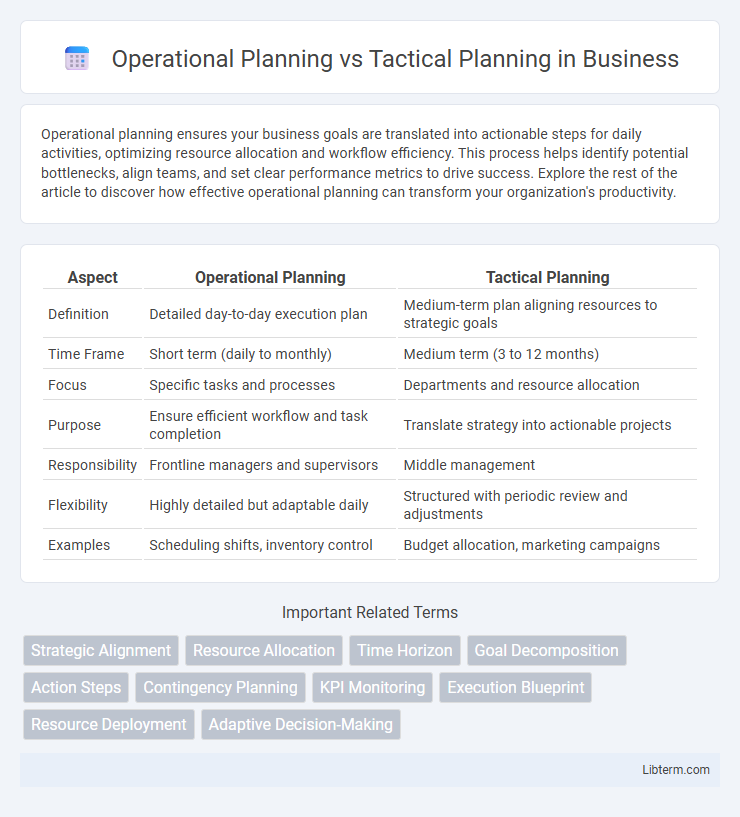Operational planning ensures your business goals are translated into actionable steps for daily activities, optimizing resource allocation and workflow efficiency. This process helps identify potential bottlenecks, align teams, and set clear performance metrics to drive success. Explore the rest of the article to discover how effective operational planning can transform your organization's productivity.
Table of Comparison
| Aspect | Operational Planning | Tactical Planning |
|---|---|---|
| Definition | Detailed day-to-day execution plan | Medium-term plan aligning resources to strategic goals |
| Time Frame | Short term (daily to monthly) | Medium term (3 to 12 months) |
| Focus | Specific tasks and processes | Departments and resource allocation |
| Purpose | Ensure efficient workflow and task completion | Translate strategy into actionable projects |
| Responsibility | Frontline managers and supervisors | Middle management |
| Flexibility | Highly detailed but adaptable daily | Structured with periodic review and adjustments |
| Examples | Scheduling shifts, inventory control | Budget allocation, marketing campaigns |
Understanding Operational Planning
Operational planning defines specific short-term actions, resource allocation, and timeline management to achieve broader tactical objectives within organizations. It translates tactical plans into detailed workflows that guide daily activities and ensure efficiency in meeting performance targets. Understanding operational planning involves recognizing its role in coordinating personnel, managing budgets, and monitoring progress to optimize organizational output.
Defining Tactical Planning
Tactical planning involves the development of short-term actions and resource allocations designed to achieve specific objectives within operational frameworks. It translates strategic goals into concrete tasks, defining timelines, responsibilities, and performance metrics that guide day-to-day functions. The emphasis lies on adaptability and efficiency in responding to immediate challenges while aligning with overall organizational strategy.
Key Differences Between Operational and Tactical Planning
Operational planning focuses on the specific procedures, resources, and schedules necessary to achieve daily or short-term goals, typically spanning weeks to months. Tactical planning translates broader strategic objectives into actionable steps, concentrating on medium-term outcomes and resource allocation over several months to a year. The key difference lies in operational planning's emphasis on routine task execution, while tactical planning centers on bridging the gap between strategic plans and operational activities through prioritized initiatives.
Objectives of Operational Planning
Operational planning focuses on defining specific, short-term objectives that translate strategic goals into actionable tasks, ensuring efficient resource allocation and daily activities alignment. It emphasizes measurable outcomes, timelines, and responsibilities to achieve immediate performance targets within departments or teams. This planning level supports overall business strategy by addressing operational efficiency and effectiveness through detailed scheduling and workflow management.
Goals of Tactical Planning
Tactical planning focuses on translating strategic goals into specific, short-term objectives and actionable steps within departments or teams. It aims to allocate resources efficiently, set performance targets, and coordinate activities to achieve measurable outcomes aligned with the overall strategy. Effective tactical planning ensures operational activities contribute directly to organizational growth and competitive advantage.
Time Frames: Operational vs Tactical Planning
Operational planning typically focuses on short-term time frames ranging from days to months, emphasizing immediate actions and resource allocation to support overall objectives. Tactical planning covers medium-term periods, often spanning months to a year, bridging the gap between strategic goals and daily operations by defining specific projects and initiatives. Understanding these distinct time horizons enhances coordination and alignment within organizational planning processes.
Roles and Responsibilities in Each Planning Type
Operational planning focuses on the roles and responsibilities of frontline managers and team leaders who implement daily tasks aligned with strategic goals, ensuring resource allocation and process efficiency. Tactical planning assigns middle managers the responsibility of translating strategic objectives into medium-term initiatives, coordinating departments, and managing project timelines to bridge the gap between strategic intent and operational execution. Clear delineation of these roles enhances organizational coordination and facilitates goal achievement across different hierarchical levels.
Tools and Techniques for Operational and Tactical Planning
Operational planning utilizes tools such as Gantt charts, workflow diagrams, and resource allocation matrices to detail daily tasks and optimize short-term processes. Tactical planning employs techniques like SWOT analysis, balanced scorecards, and scenario planning to align mid-term objectives with strategic goals. Both planning types leverage software platforms that integrate data analytics and performance monitoring to enhance decision-making accuracy.
Real-World Examples: Operational vs Tactical Planning
Operational planning involves creating detailed workflows and schedules to manage day-to-day activities, such as a manufacturing plant organizing daily production runs to meet order deadlines. Tactical planning focuses on short- to medium-term actions that support strategic goals, exemplified by a retail chain launching a seasonal promotional campaign to increase market share during a competitive quarter. Companies often use operational planning to optimize resources and maintain efficiency, while tactical planning adjusts business activities to respond to changing market conditions and competitive pressures.
Choosing the Right Approach for Your Organization
Operational planning focuses on short-term, day-to-day activities essential for meeting specific organizational goals, while tactical planning bridges strategic objectives with operational actions by outlining medium-term initiatives. Selecting the right approach depends on your organization's size, industry, and immediate priorities; small businesses may prioritize operational planning for efficiency, whereas larger corporations benefit from tactical planning to align diverse departments. Leveraging data analytics and performance metrics can guide decision-making to tailor planning processes that optimize resource allocation and achieve measurable outcomes.
Operational Planning Infographic

 libterm.com
libterm.com